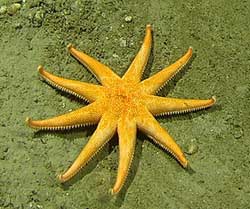Unique images from the deep

Sunstar (Solaster sp.) at 300 metres depth in the Barents Sea.
Whereas sampling with different kinds of equipment is normally used to collect information on bottom fauna, a specially designed video rig has allowed the scientists to film 80 kilometres of seabed during their survey off the coast of northern Norway. The seabed in the area is characterised by deep fjords and shelf areas with fishing banks and intersecting channels. Many of the habitats found here are complex and not easily documented with standard sampling gears.
Better knowledge of the ecosystem
The recent survey was conducted as part of a large-scale mapping programme. Biologists from the Institute of Marine Research, geologists from the Geological Survey of Norway, and cartographers from the Norwegian Hydrographic Service cooperate through the MAREANO programme to provide maps of topography, biodiversity and geological conditions of the seabed in Norwegian waters. Initially focusing on the Barents Sea, the first phase of MAREANO will be carried out from 2005-2010 with a total cost of € 30 million.
The importance of this seabed mapping is emphasised in the Integrated Management Plan for the Barents Sea recently presented by the Norwegian Government. Extensive plans for exploitation of oil and gas reserves in Lofoten and the Barents Sea are being considered, and a sustainable management of the area is highly dependent on improved knowledge of the Arctic ecosystems.
Media Contact
More Information:
http://www.imr.no/englishAll latest news from the category: Ecology, The Environment and Conservation
This complex theme deals primarily with interactions between organisms and the environmental factors that impact them, but to a greater extent between individual inanimate environmental factors.
innovations-report offers informative reports and articles on topics such as climate protection, landscape conservation, ecological systems, wildlife and nature parks and ecosystem efficiency and balance.
Newest articles

Zap Energy achieves 37-million-degree temperatures in a compact device
New publication reports record electron temperatures for a small-scale, sheared-flow-stabilized Z-pinch fusion device. In the nine decades since humans first produced fusion reactions, only a few fusion technologies have demonstrated…

Innovative microscopy demystifies metabolism of Alzheimer’s
Researchers at UC San Diego have deployed state-of-the art imaging techniques to discover the metabolism driving Alzheimer’s disease; results suggest new treatment strategies. Alzheimer’s disease causes significant problems with memory,…

A cause of immunodeficiency identified
After stroke and heart attack: Every year, between 250,000 and 300,000 people in Germany suffer from a stroke or heart attack. These patients suffer immune disturbances and are very frequently…





















